UML Sequence Diagrams Analysis and Applications
VerifiedAdded on 2020/05/16
|13
|2735
|410
AI Summary
This assignment delves into the multifaceted world of UML sequence diagrams. It presents a collection of research papers examining diverse techniques for analyzing and utilizing these diagrams. Topics covered range from verifying behavior preservation through graph models to automating test case generation based on sequence diagrams and object constraint language. The papers also explore applications in areas like distributed systems testing, clone detection, formal specification integration, and aspect-oriented programming.
Contribute Materials
Your contribution can guide someone’s learning journey. Share your
documents today.
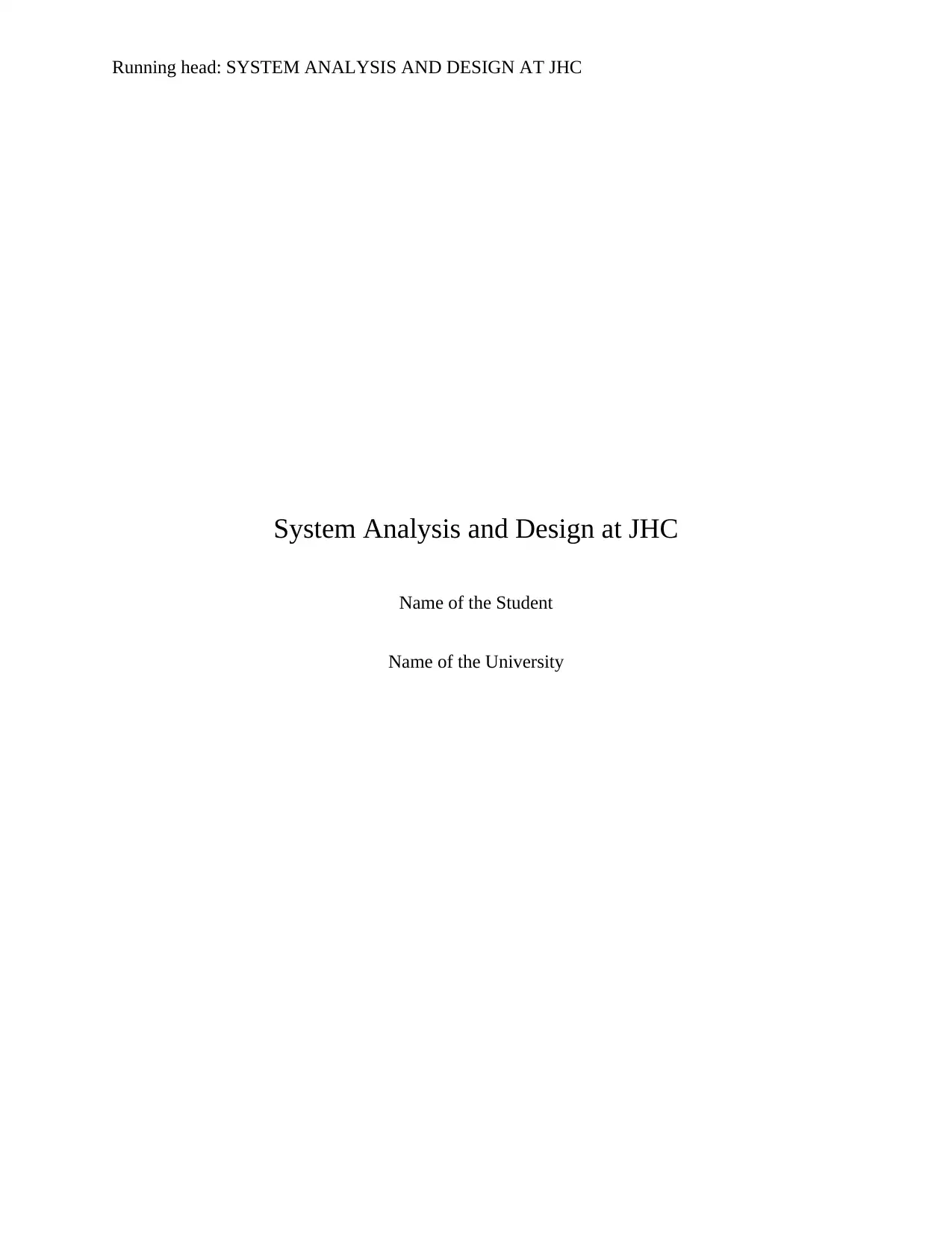
Running head: SYSTEM ANALYSIS AND DESIGN AT JHC
System Analysis and Design at JHC
Name of the Student
Name of the University
System Analysis and Design at JHC
Name of the Student
Name of the University
Secure Best Marks with AI Grader
Need help grading? Try our AI Grader for instant feedback on your assignments.
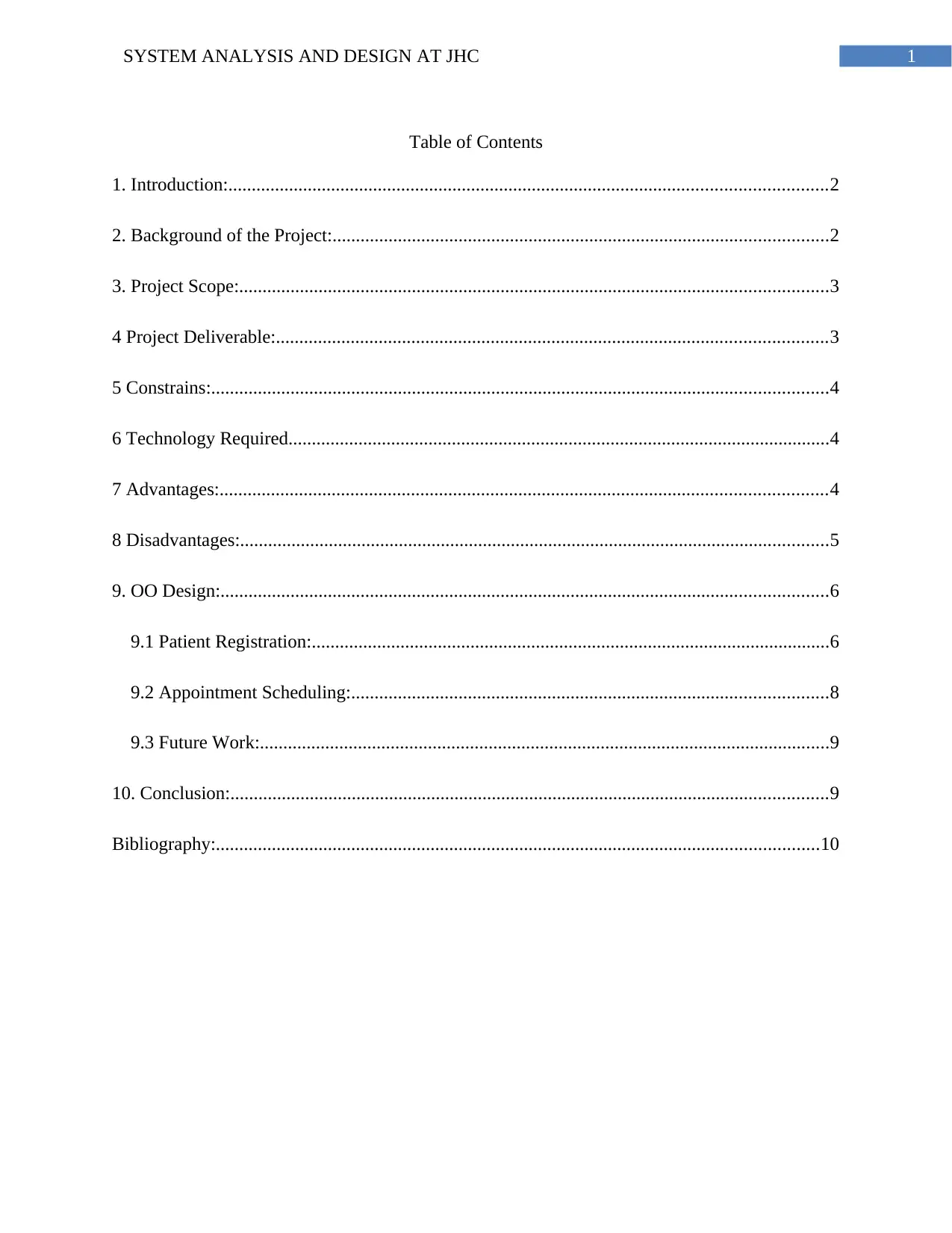
1SYSTEM ANALYSIS AND DESIGN AT JHC
Table of Contents
1. Introduction:................................................................................................................................2
2. Background of the Project:..........................................................................................................2
3. Project Scope:..............................................................................................................................3
4 Project Deliverable:......................................................................................................................3
5 Constrains:....................................................................................................................................4
6 Technology Required....................................................................................................................4
7 Advantages:..................................................................................................................................4
8 Disadvantages:..............................................................................................................................5
9. OO Design:..................................................................................................................................6
9.1 Patient Registration:...............................................................................................................6
9.2 Appointment Scheduling:......................................................................................................8
9.3 Future Work:..........................................................................................................................9
10. Conclusion:................................................................................................................................9
Bibliography:.................................................................................................................................10
Table of Contents
1. Introduction:................................................................................................................................2
2. Background of the Project:..........................................................................................................2
3. Project Scope:..............................................................................................................................3
4 Project Deliverable:......................................................................................................................3
5 Constrains:....................................................................................................................................4
6 Technology Required....................................................................................................................4
7 Advantages:..................................................................................................................................4
8 Disadvantages:..............................................................................................................................5
9. OO Design:..................................................................................................................................6
9.1 Patient Registration:...............................................................................................................6
9.2 Appointment Scheduling:......................................................................................................8
9.3 Future Work:..........................................................................................................................9
10. Conclusion:................................................................................................................................9
Bibliography:.................................................................................................................................10
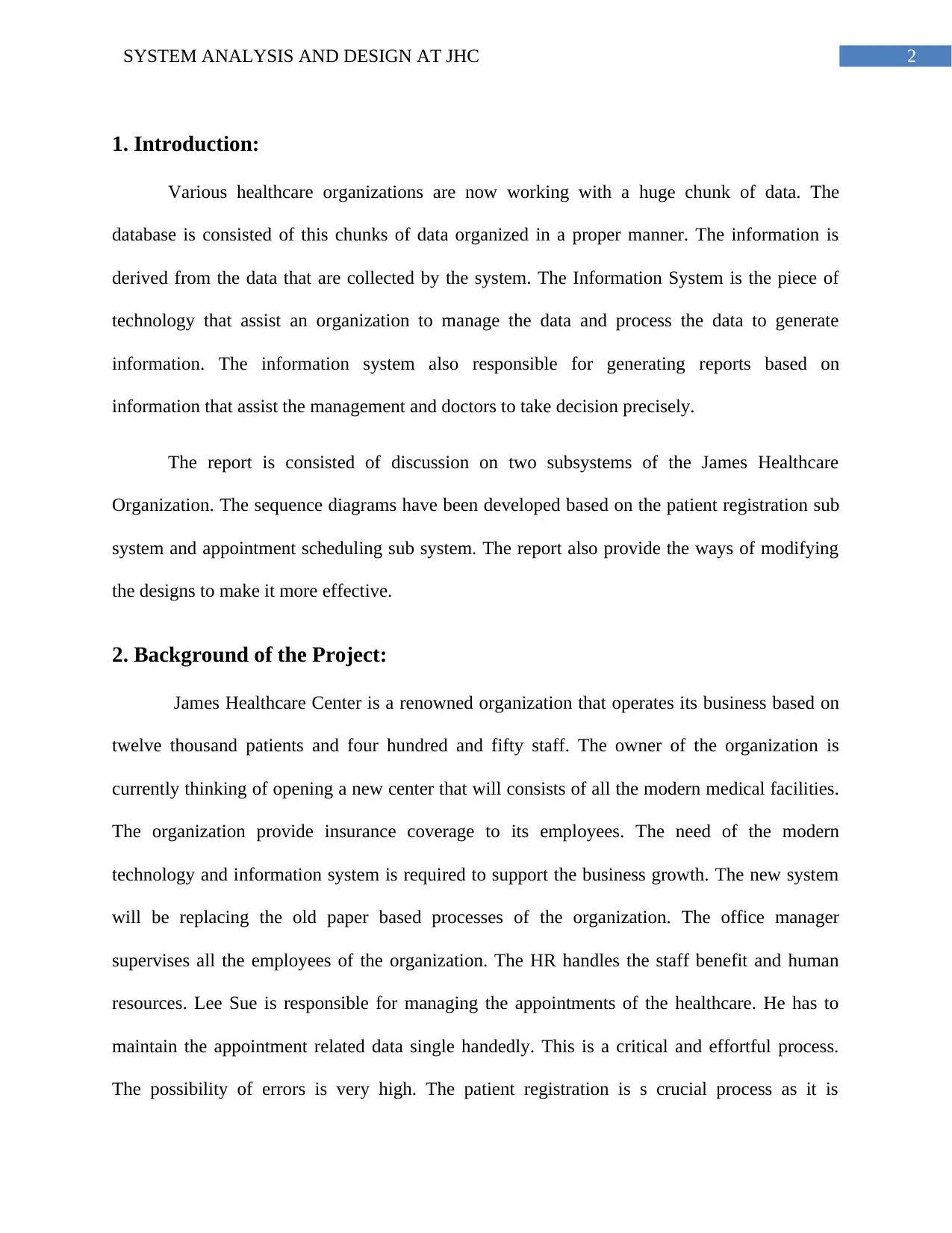
2SYSTEM ANALYSIS AND DESIGN AT JHC
1. Introduction:
Various healthcare organizations are now working with a huge chunk of data. The
database is consisted of this chunks of data organized in a proper manner. The information is
derived from the data that are collected by the system. The Information System is the piece of
technology that assist an organization to manage the data and process the data to generate
information. The information system also responsible for generating reports based on
information that assist the management and doctors to take decision precisely.
The report is consisted of discussion on two subsystems of the James Healthcare
Organization. The sequence diagrams have been developed based on the patient registration sub
system and appointment scheduling sub system. The report also provide the ways of modifying
the designs to make it more effective.
2. Background of the Project:
James Healthcare Center is a renowned organization that operates its business based on
twelve thousand patients and four hundred and fifty staff. The owner of the organization is
currently thinking of opening a new center that will consists of all the modern medical facilities.
The organization provide insurance coverage to its employees. The need of the modern
technology and information system is required to support the business growth. The new system
will be replacing the old paper based processes of the organization. The office manager
supervises all the employees of the organization. The HR handles the staff benefit and human
resources. Lee Sue is responsible for managing the appointments of the healthcare. He has to
maintain the appointment related data single handedly. This is a critical and effortful process.
The possibility of errors is very high. The patient registration is s crucial process as it is
1. Introduction:
Various healthcare organizations are now working with a huge chunk of data. The
database is consisted of this chunks of data organized in a proper manner. The information is
derived from the data that are collected by the system. The Information System is the piece of
technology that assist an organization to manage the data and process the data to generate
information. The information system also responsible for generating reports based on
information that assist the management and doctors to take decision precisely.
The report is consisted of discussion on two subsystems of the James Healthcare
Organization. The sequence diagrams have been developed based on the patient registration sub
system and appointment scheduling sub system. The report also provide the ways of modifying
the designs to make it more effective.
2. Background of the Project:
James Healthcare Center is a renowned organization that operates its business based on
twelve thousand patients and four hundred and fifty staff. The owner of the organization is
currently thinking of opening a new center that will consists of all the modern medical facilities.
The organization provide insurance coverage to its employees. The need of the modern
technology and information system is required to support the business growth. The new system
will be replacing the old paper based processes of the organization. The office manager
supervises all the employees of the organization. The HR handles the staff benefit and human
resources. Lee Sue is responsible for managing the appointments of the healthcare. He has to
maintain the appointment related data single handedly. This is a critical and effortful process.
The possibility of errors is very high. The patient registration is s crucial process as it is
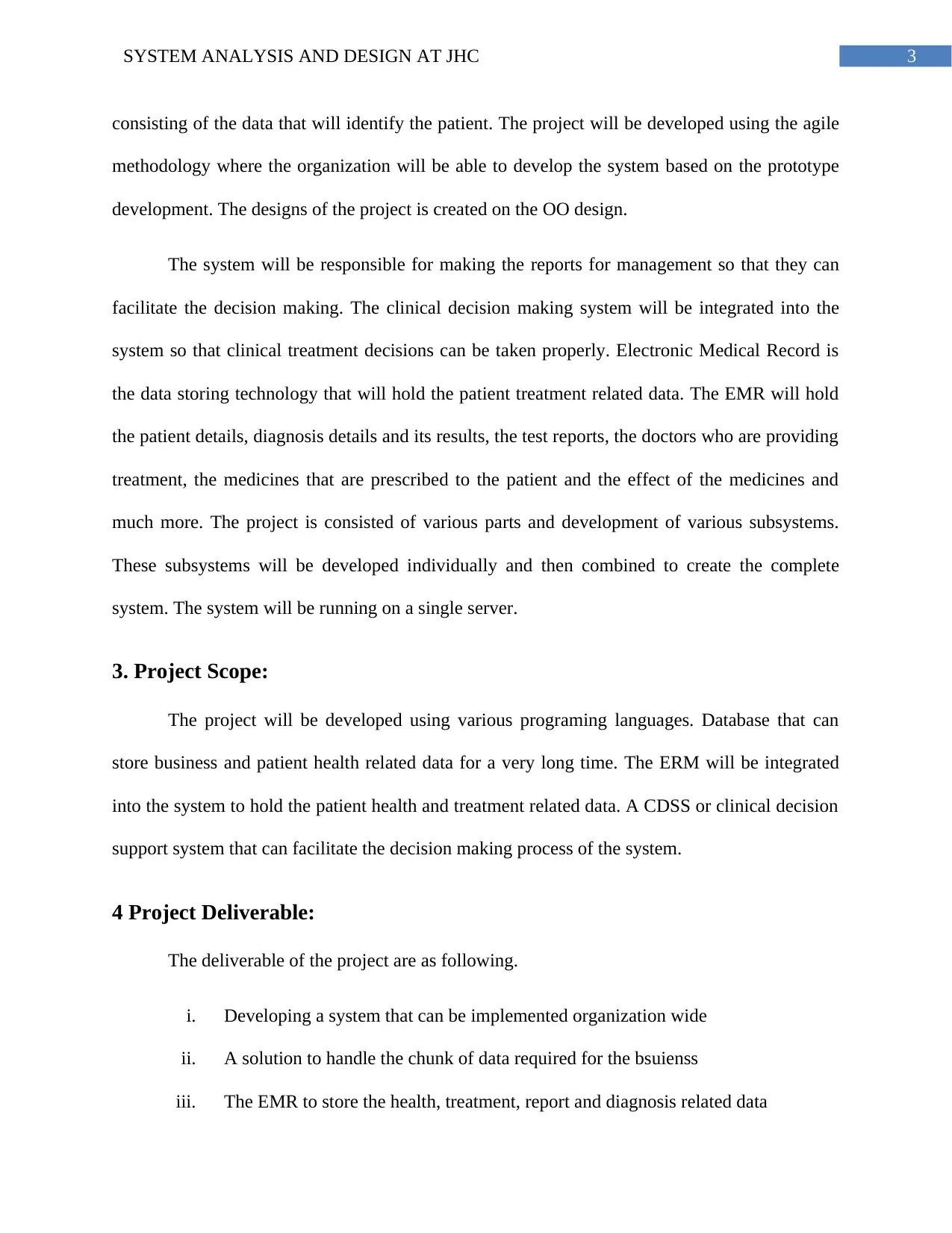
3SYSTEM ANALYSIS AND DESIGN AT JHC
consisting of the data that will identify the patient. The project will be developed using the agile
methodology where the organization will be able to develop the system based on the prototype
development. The designs of the project is created on the OO design.
The system will be responsible for making the reports for management so that they can
facilitate the decision making. The clinical decision making system will be integrated into the
system so that clinical treatment decisions can be taken properly. Electronic Medical Record is
the data storing technology that will hold the patient treatment related data. The EMR will hold
the patient details, diagnosis details and its results, the test reports, the doctors who are providing
treatment, the medicines that are prescribed to the patient and the effect of the medicines and
much more. The project is consisted of various parts and development of various subsystems.
These subsystems will be developed individually and then combined to create the complete
system. The system will be running on a single server.
3. Project Scope:
The project will be developed using various programing languages. Database that can
store business and patient health related data for a very long time. The ERM will be integrated
into the system to hold the patient health and treatment related data. A CDSS or clinical decision
support system that can facilitate the decision making process of the system.
4 Project Deliverable:
The deliverable of the project are as following.
i. Developing a system that can be implemented organization wide
ii. A solution to handle the chunk of data required for the bsuienss
iii. The EMR to store the health, treatment, report and diagnosis related data
consisting of the data that will identify the patient. The project will be developed using the agile
methodology where the organization will be able to develop the system based on the prototype
development. The designs of the project is created on the OO design.
The system will be responsible for making the reports for management so that they can
facilitate the decision making. The clinical decision making system will be integrated into the
system so that clinical treatment decisions can be taken properly. Electronic Medical Record is
the data storing technology that will hold the patient treatment related data. The EMR will hold
the patient details, diagnosis details and its results, the test reports, the doctors who are providing
treatment, the medicines that are prescribed to the patient and the effect of the medicines and
much more. The project is consisted of various parts and development of various subsystems.
These subsystems will be developed individually and then combined to create the complete
system. The system will be running on a single server.
3. Project Scope:
The project will be developed using various programing languages. Database that can
store business and patient health related data for a very long time. The ERM will be integrated
into the system to hold the patient health and treatment related data. A CDSS or clinical decision
support system that can facilitate the decision making process of the system.
4 Project Deliverable:
The deliverable of the project are as following.
i. Developing a system that can be implemented organization wide
ii. A solution to handle the chunk of data required for the bsuienss
iii. The EMR to store the health, treatment, report and diagnosis related data
Secure Best Marks with AI Grader
Need help grading? Try our AI Grader for instant feedback on your assignments.
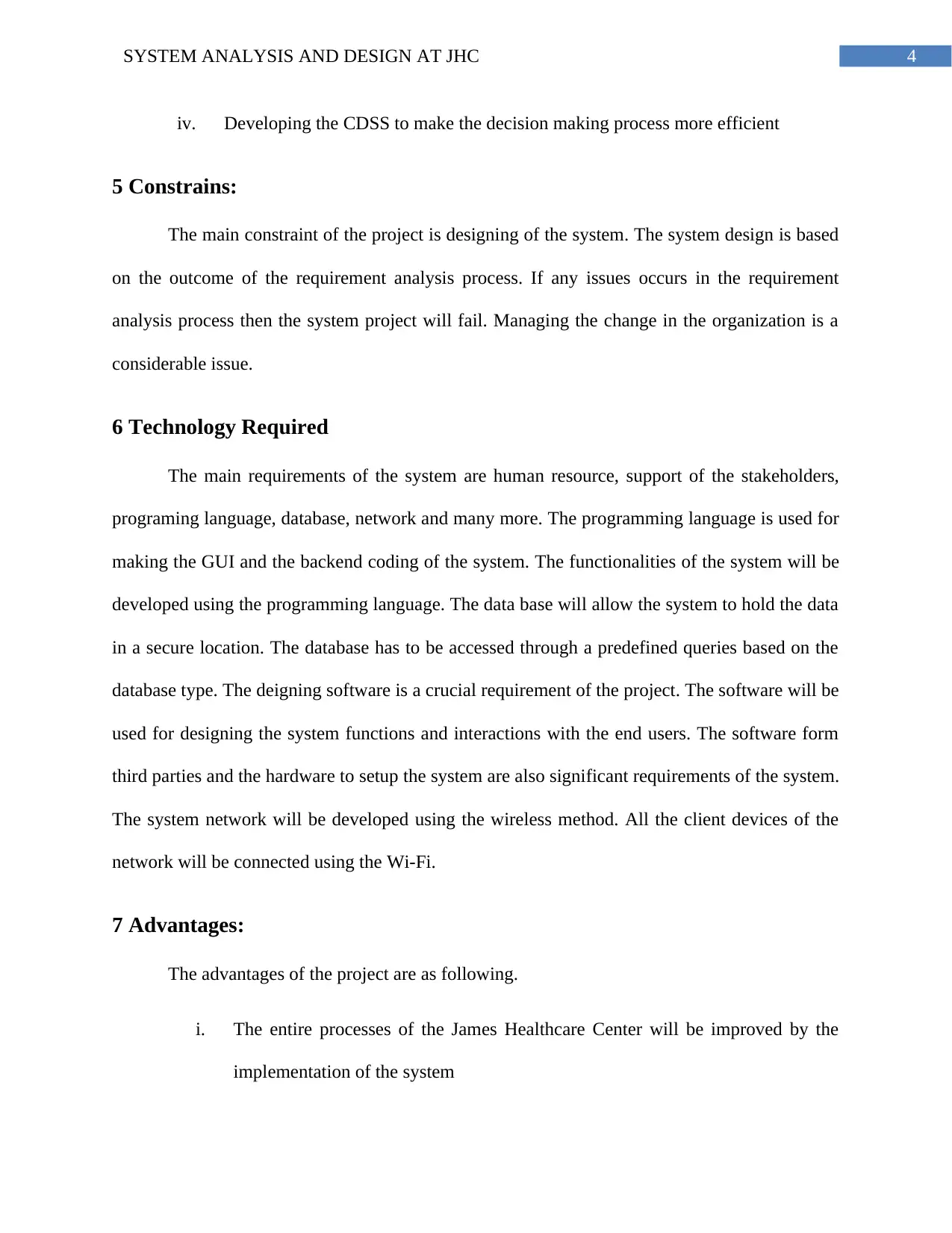
4SYSTEM ANALYSIS AND DESIGN AT JHC
iv. Developing the CDSS to make the decision making process more efficient
5 Constrains:
The main constraint of the project is designing of the system. The system design is based
on the outcome of the requirement analysis process. If any issues occurs in the requirement
analysis process then the system project will fail. Managing the change in the organization is a
considerable issue.
6 Technology Required
The main requirements of the system are human resource, support of the stakeholders,
programing language, database, network and many more. The programming language is used for
making the GUI and the backend coding of the system. The functionalities of the system will be
developed using the programming language. The data base will allow the system to hold the data
in a secure location. The database has to be accessed through a predefined queries based on the
database type. The deigning software is a crucial requirement of the project. The software will be
used for designing the system functions and interactions with the end users. The software form
third parties and the hardware to setup the system are also significant requirements of the system.
The system network will be developed using the wireless method. All the client devices of the
network will be connected using the Wi-Fi.
7 Advantages:
The advantages of the project are as following.
i. The entire processes of the James Healthcare Center will be improved by the
implementation of the system
iv. Developing the CDSS to make the decision making process more efficient
5 Constrains:
The main constraint of the project is designing of the system. The system design is based
on the outcome of the requirement analysis process. If any issues occurs in the requirement
analysis process then the system project will fail. Managing the change in the organization is a
considerable issue.
6 Technology Required
The main requirements of the system are human resource, support of the stakeholders,
programing language, database, network and many more. The programming language is used for
making the GUI and the backend coding of the system. The functionalities of the system will be
developed using the programming language. The data base will allow the system to hold the data
in a secure location. The database has to be accessed through a predefined queries based on the
database type. The deigning software is a crucial requirement of the project. The software will be
used for designing the system functions and interactions with the end users. The software form
third parties and the hardware to setup the system are also significant requirements of the system.
The system network will be developed using the wireless method. All the client devices of the
network will be connected using the Wi-Fi.
7 Advantages:
The advantages of the project are as following.
i. The entire processes of the James Healthcare Center will be improved by the
implementation of the system
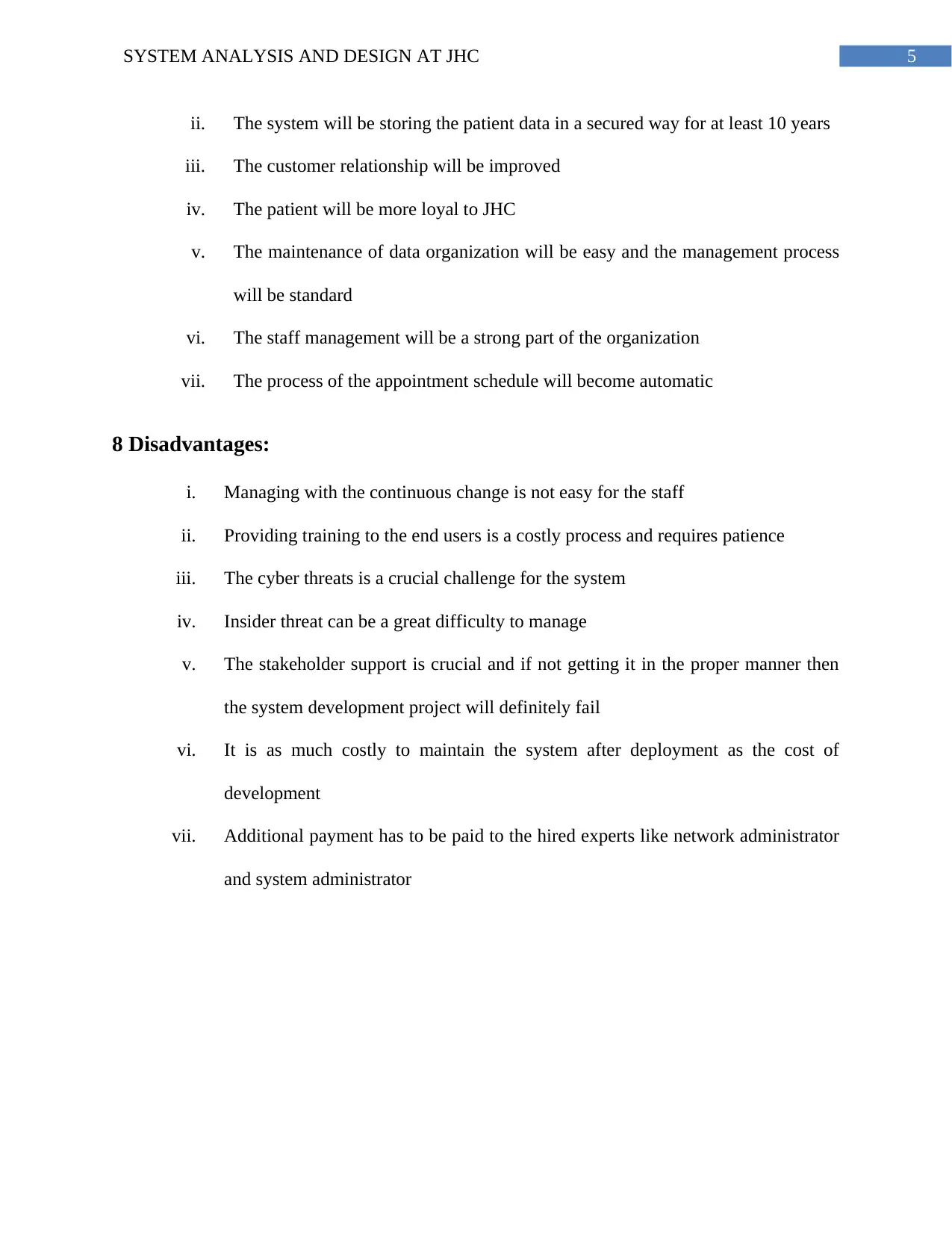
5SYSTEM ANALYSIS AND DESIGN AT JHC
ii. The system will be storing the patient data in a secured way for at least 10 years
iii. The customer relationship will be improved
iv. The patient will be more loyal to JHC
v. The maintenance of data organization will be easy and the management process
will be standard
vi. The staff management will be a strong part of the organization
vii. The process of the appointment schedule will become automatic
8 Disadvantages:
i. Managing with the continuous change is not easy for the staff
ii. Providing training to the end users is a costly process and requires patience
iii. The cyber threats is a crucial challenge for the system
iv. Insider threat can be a great difficulty to manage
v. The stakeholder support is crucial and if not getting it in the proper manner then
the system development project will definitely fail
vi. It is as much costly to maintain the system after deployment as the cost of
development
vii. Additional payment has to be paid to the hired experts like network administrator
and system administrator
ii. The system will be storing the patient data in a secured way for at least 10 years
iii. The customer relationship will be improved
iv. The patient will be more loyal to JHC
v. The maintenance of data organization will be easy and the management process
will be standard
vi. The staff management will be a strong part of the organization
vii. The process of the appointment schedule will become automatic
8 Disadvantages:
i. Managing with the continuous change is not easy for the staff
ii. Providing training to the end users is a costly process and requires patience
iii. The cyber threats is a crucial challenge for the system
iv. Insider threat can be a great difficulty to manage
v. The stakeholder support is crucial and if not getting it in the proper manner then
the system development project will definitely fail
vi. It is as much costly to maintain the system after deployment as the cost of
development
vii. Additional payment has to be paid to the hired experts like network administrator
and system administrator

6SYSTEM ANALYSIS AND DESIGN AT JHC
9. OO Design:
9.1 Patient Registration:
Figure 1: Patient Registration Subsystem Sequence Diagram
(Source: Created by the Author)
Verification and Analysis: The sub-system design has been done using the system
sequence diagram. The diagrams has been done properly to establishing a fine understanding of
the sub-system processes. At the beginning, the patient will open the application or website
(which is no concern of the report) and enter the details. The details will be consisting of the data
like patient personal data such as name, address, spouse, age, email address, phone number and
9. OO Design:
9.1 Patient Registration:
Figure 1: Patient Registration Subsystem Sequence Diagram
(Source: Created by the Author)
Verification and Analysis: The sub-system design has been done using the system
sequence diagram. The diagrams has been done properly to establishing a fine understanding of
the sub-system processes. At the beginning, the patient will open the application or website
(which is no concern of the report) and enter the details. The details will be consisting of the data
like patient personal data such as name, address, spouse, age, email address, phone number and
Paraphrase This Document
Need a fresh take? Get an instant paraphrase of this document with our AI Paraphraser
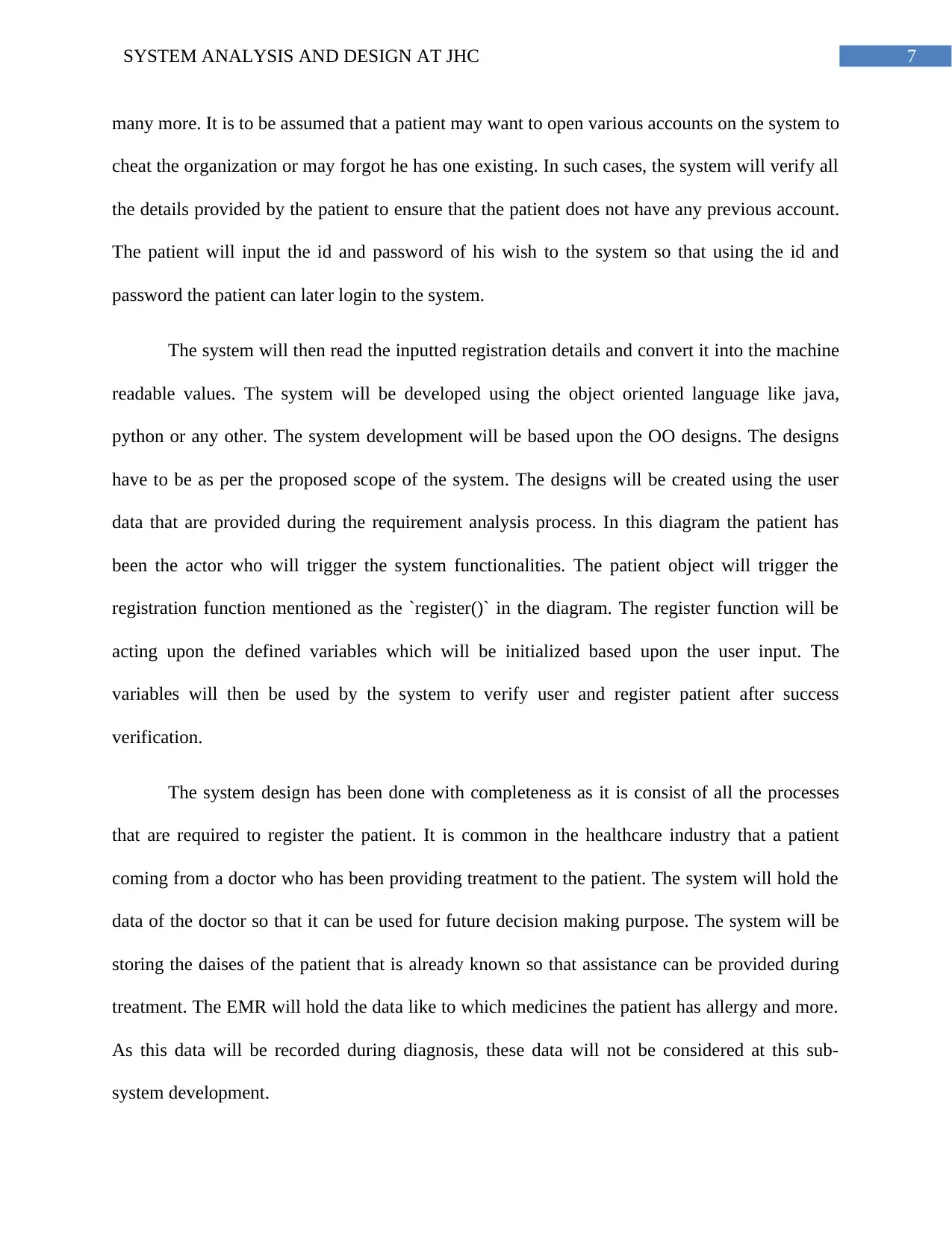
7SYSTEM ANALYSIS AND DESIGN AT JHC
many more. It is to be assumed that a patient may want to open various accounts on the system to
cheat the organization or may forgot he has one existing. In such cases, the system will verify all
the details provided by the patient to ensure that the patient does not have any previous account.
The patient will input the id and password of his wish to the system so that using the id and
password the patient can later login to the system.
The system will then read the inputted registration details and convert it into the machine
readable values. The system will be developed using the object oriented language like java,
python or any other. The system development will be based upon the OO designs. The designs
have to be as per the proposed scope of the system. The designs will be created using the user
data that are provided during the requirement analysis process. In this diagram the patient has
been the actor who will trigger the system functionalities. The patient object will trigger the
registration function mentioned as the `register()` in the diagram. The register function will be
acting upon the defined variables which will be initialized based upon the user input. The
variables will then be used by the system to verify user and register patient after success
verification.
The system design has been done with completeness as it is consist of all the processes
that are required to register the patient. It is common in the healthcare industry that a patient
coming from a doctor who has been providing treatment to the patient. The system will hold the
data of the doctor so that it can be used for future decision making purpose. The system will be
storing the daises of the patient that is already known so that assistance can be provided during
treatment. The EMR will hold the data like to which medicines the patient has allergy and more.
As this data will be recorded during diagnosis, these data will not be considered at this sub-
system development.
many more. It is to be assumed that a patient may want to open various accounts on the system to
cheat the organization or may forgot he has one existing. In such cases, the system will verify all
the details provided by the patient to ensure that the patient does not have any previous account.
The patient will input the id and password of his wish to the system so that using the id and
password the patient can later login to the system.
The system will then read the inputted registration details and convert it into the machine
readable values. The system will be developed using the object oriented language like java,
python or any other. The system development will be based upon the OO designs. The designs
have to be as per the proposed scope of the system. The designs will be created using the user
data that are provided during the requirement analysis process. In this diagram the patient has
been the actor who will trigger the system functionalities. The patient object will trigger the
registration function mentioned as the `register()` in the diagram. The register function will be
acting upon the defined variables which will be initialized based upon the user input. The
variables will then be used by the system to verify user and register patient after success
verification.
The system design has been done with completeness as it is consist of all the processes
that are required to register the patient. It is common in the healthcare industry that a patient
coming from a doctor who has been providing treatment to the patient. The system will hold the
data of the doctor so that it can be used for future decision making purpose. The system will be
storing the daises of the patient that is already known so that assistance can be provided during
treatment. The EMR will hold the data like to which medicines the patient has allergy and more.
As this data will be recorded during diagnosis, these data will not be considered at this sub-
system development.
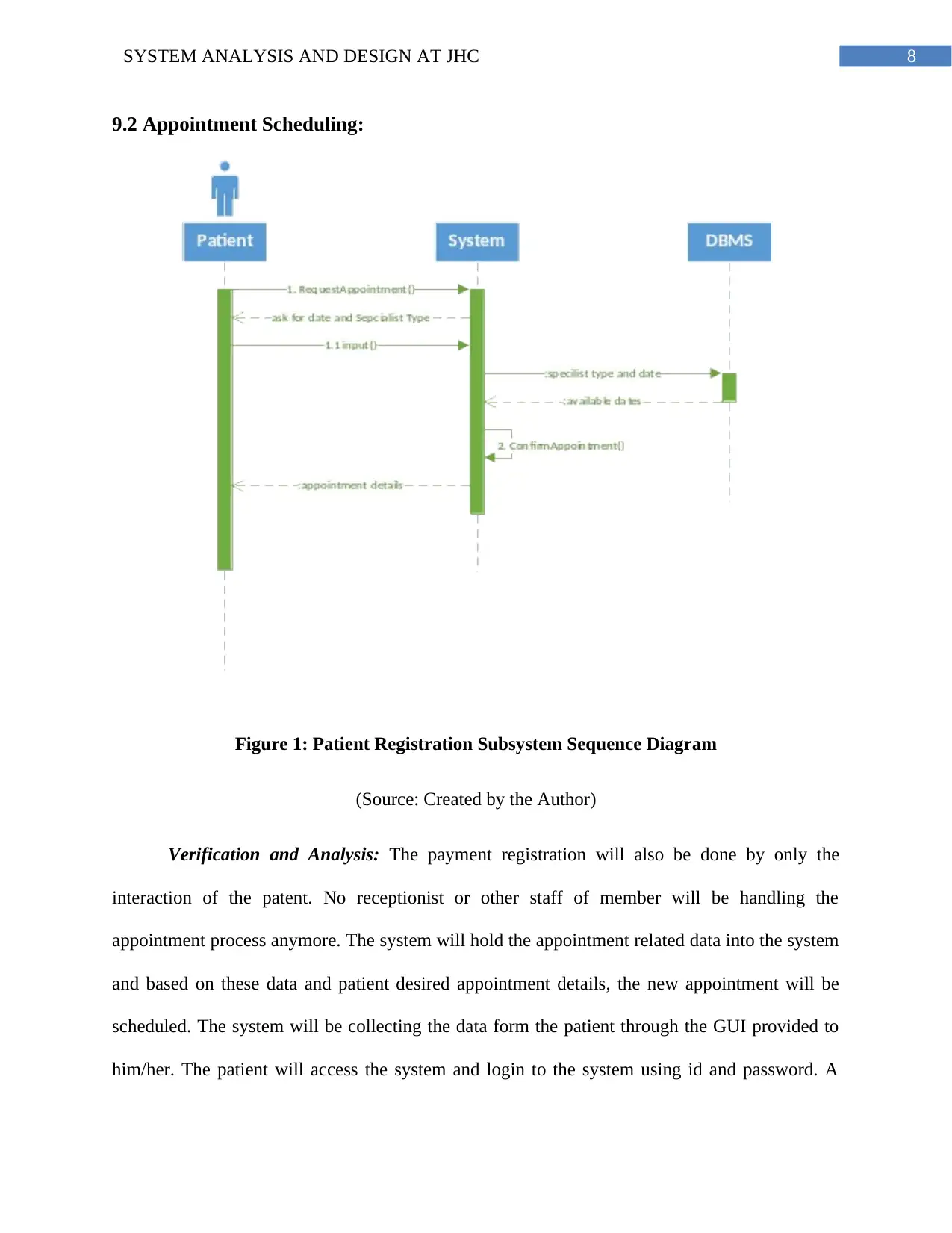
8SYSTEM ANALYSIS AND DESIGN AT JHC
9.2 Appointment Scheduling:
Figure 1: Patient Registration Subsystem Sequence Diagram
(Source: Created by the Author)
Verification and Analysis: The payment registration will also be done by only the
interaction of the patent. No receptionist or other staff of member will be handling the
appointment process anymore. The system will hold the appointment related data into the system
and based on these data and patient desired appointment details, the new appointment will be
scheduled. The system will be collecting the data form the patient through the GUI provided to
him/her. The patient will access the system and login to the system using id and password. A
9.2 Appointment Scheduling:
Figure 1: Patient Registration Subsystem Sequence Diagram
(Source: Created by the Author)
Verification and Analysis: The payment registration will also be done by only the
interaction of the patent. No receptionist or other staff of member will be handling the
appointment process anymore. The system will hold the appointment related data into the system
and based on these data and patient desired appointment details, the new appointment will be
scheduled. The system will be collecting the data form the patient through the GUI provided to
him/her. The patient will access the system and login to the system using id and password. A
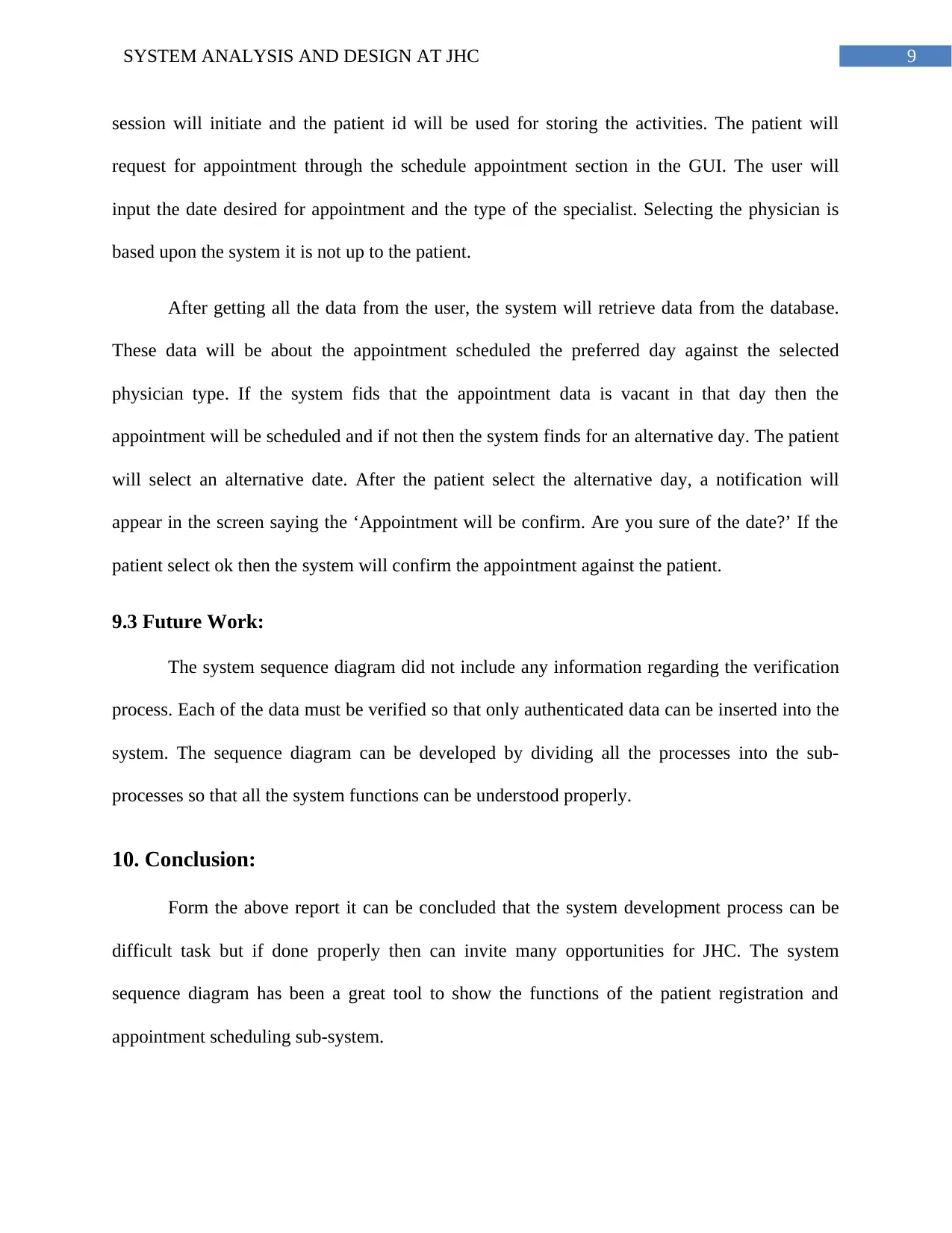
9SYSTEM ANALYSIS AND DESIGN AT JHC
session will initiate and the patient id will be used for storing the activities. The patient will
request for appointment through the schedule appointment section in the GUI. The user will
input the date desired for appointment and the type of the specialist. Selecting the physician is
based upon the system it is not up to the patient.
After getting all the data from the user, the system will retrieve data from the database.
These data will be about the appointment scheduled the preferred day against the selected
physician type. If the system fids that the appointment data is vacant in that day then the
appointment will be scheduled and if not then the system finds for an alternative day. The patient
will select an alternative date. After the patient select the alternative day, a notification will
appear in the screen saying the ‘Appointment will be confirm. Are you sure of the date?’ If the
patient select ok then the system will confirm the appointment against the patient.
9.3 Future Work:
The system sequence diagram did not include any information regarding the verification
process. Each of the data must be verified so that only authenticated data can be inserted into the
system. The sequence diagram can be developed by dividing all the processes into the sub-
processes so that all the system functions can be understood properly.
10. Conclusion:
Form the above report it can be concluded that the system development process can be
difficult task but if done properly then can invite many opportunities for JHC. The system
sequence diagram has been a great tool to show the functions of the patient registration and
appointment scheduling sub-system.
session will initiate and the patient id will be used for storing the activities. The patient will
request for appointment through the schedule appointment section in the GUI. The user will
input the date desired for appointment and the type of the specialist. Selecting the physician is
based upon the system it is not up to the patient.
After getting all the data from the user, the system will retrieve data from the database.
These data will be about the appointment scheduled the preferred day against the selected
physician type. If the system fids that the appointment data is vacant in that day then the
appointment will be scheduled and if not then the system finds for an alternative day. The patient
will select an alternative date. After the patient select the alternative day, a notification will
appear in the screen saying the ‘Appointment will be confirm. Are you sure of the date?’ If the
patient select ok then the system will confirm the appointment against the patient.
9.3 Future Work:
The system sequence diagram did not include any information regarding the verification
process. Each of the data must be verified so that only authenticated data can be inserted into the
system. The sequence diagram can be developed by dividing all the processes into the sub-
processes so that all the system functions can be understood properly.
10. Conclusion:
Form the above report it can be concluded that the system development process can be
difficult task but if done properly then can invite many opportunities for JHC. The system
sequence diagram has been a great tool to show the functions of the patient registration and
appointment scheduling sub-system.
Secure Best Marks with AI Grader
Need help grading? Try our AI Grader for instant feedback on your assignments.
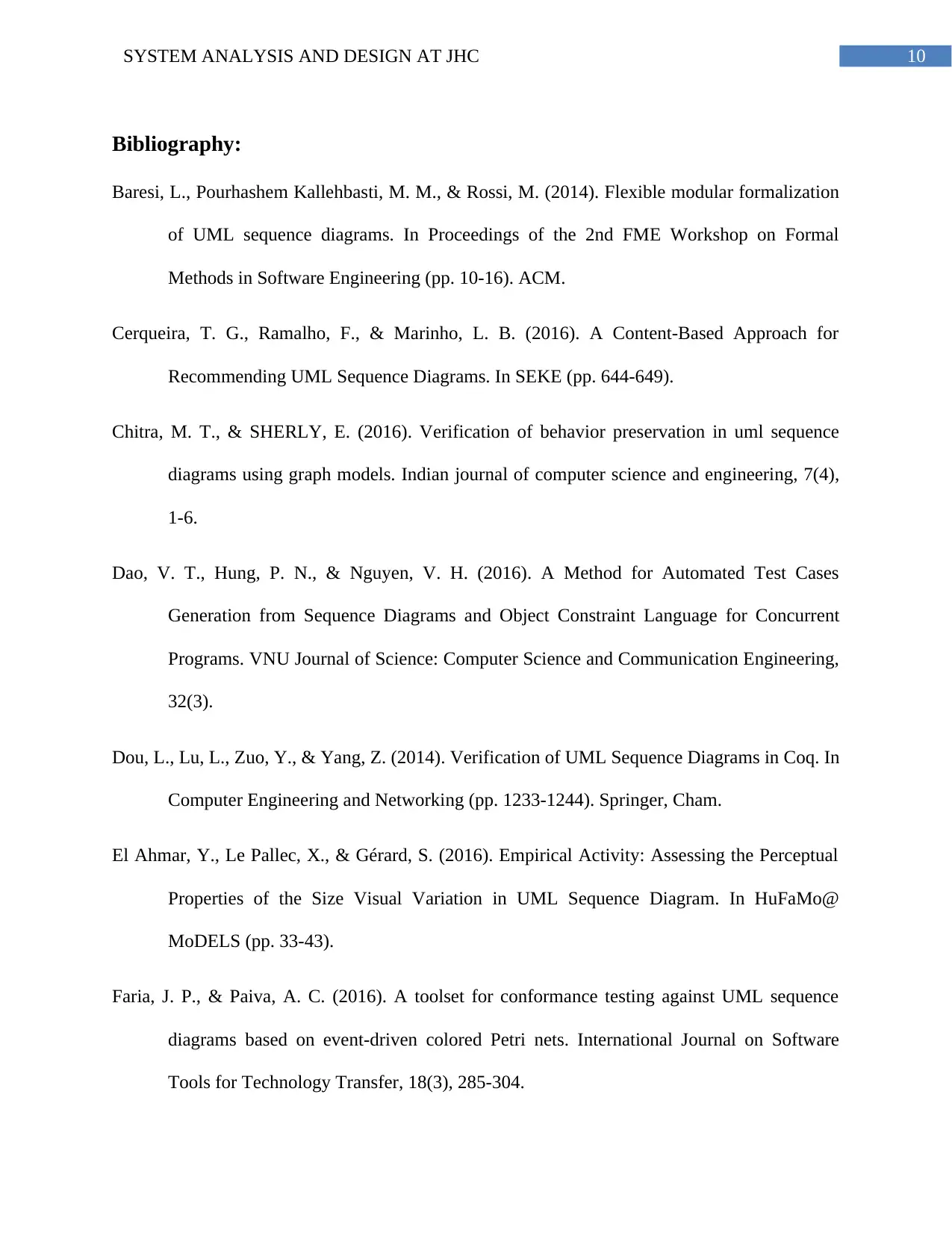
10SYSTEM ANALYSIS AND DESIGN AT JHC
Bibliography:
Baresi, L., Pourhashem Kallehbasti, M. M., & Rossi, M. (2014). Flexible modular formalization
of UML sequence diagrams. In Proceedings of the 2nd FME Workshop on Formal
Methods in Software Engineering (pp. 10-16). ACM.
Cerqueira, T. G., Ramalho, F., & Marinho, L. B. (2016). A Content-Based Approach for
Recommending UML Sequence Diagrams. In SEKE (pp. 644-649).
Chitra, M. T., & SHERLY, E. (2016). Verification of behavior preservation in uml sequence
diagrams using graph models. Indian journal of computer science and engineering, 7(4),
1-6.
Dao, V. T., Hung, P. N., & Nguyen, V. H. (2016). A Method for Automated Test Cases
Generation from Sequence Diagrams and Object Constraint Language for Concurrent
Programs. VNU Journal of Science: Computer Science and Communication Engineering,
32(3).
Dou, L., Lu, L., Zuo, Y., & Yang, Z. (2014). Verification of UML Sequence Diagrams in Coq. In
Computer Engineering and Networking (pp. 1233-1244). Springer, Cham.
El Ahmar, Y., Le Pallec, X., & Gérard, S. (2016). Empirical Activity: Assessing the Perceptual
Properties of the Size Visual Variation in UML Sequence Diagram. In HuFaMo@
MoDELS (pp. 33-43).
Faria, J. P., & Paiva, A. C. (2016). A toolset for conformance testing against UML sequence
diagrams based on event-driven colored Petri nets. International Journal on Software
Tools for Technology Transfer, 18(3), 285-304.
Bibliography:
Baresi, L., Pourhashem Kallehbasti, M. M., & Rossi, M. (2014). Flexible modular formalization
of UML sequence diagrams. In Proceedings of the 2nd FME Workshop on Formal
Methods in Software Engineering (pp. 10-16). ACM.
Cerqueira, T. G., Ramalho, F., & Marinho, L. B. (2016). A Content-Based Approach for
Recommending UML Sequence Diagrams. In SEKE (pp. 644-649).
Chitra, M. T., & SHERLY, E. (2016). Verification of behavior preservation in uml sequence
diagrams using graph models. Indian journal of computer science and engineering, 7(4),
1-6.
Dao, V. T., Hung, P. N., & Nguyen, V. H. (2016). A Method for Automated Test Cases
Generation from Sequence Diagrams and Object Constraint Language for Concurrent
Programs. VNU Journal of Science: Computer Science and Communication Engineering,
32(3).
Dou, L., Lu, L., Zuo, Y., & Yang, Z. (2014). Verification of UML Sequence Diagrams in Coq. In
Computer Engineering and Networking (pp. 1233-1244). Springer, Cham.
El Ahmar, Y., Le Pallec, X., & Gérard, S. (2016). Empirical Activity: Assessing the Perceptual
Properties of the Size Visual Variation in UML Sequence Diagram. In HuFaMo@
MoDELS (pp. 33-43).
Faria, J. P., & Paiva, A. C. (2016). A toolset for conformance testing against UML sequence
diagrams based on event-driven colored Petri nets. International Journal on Software
Tools for Technology Transfer, 18(3), 285-304.
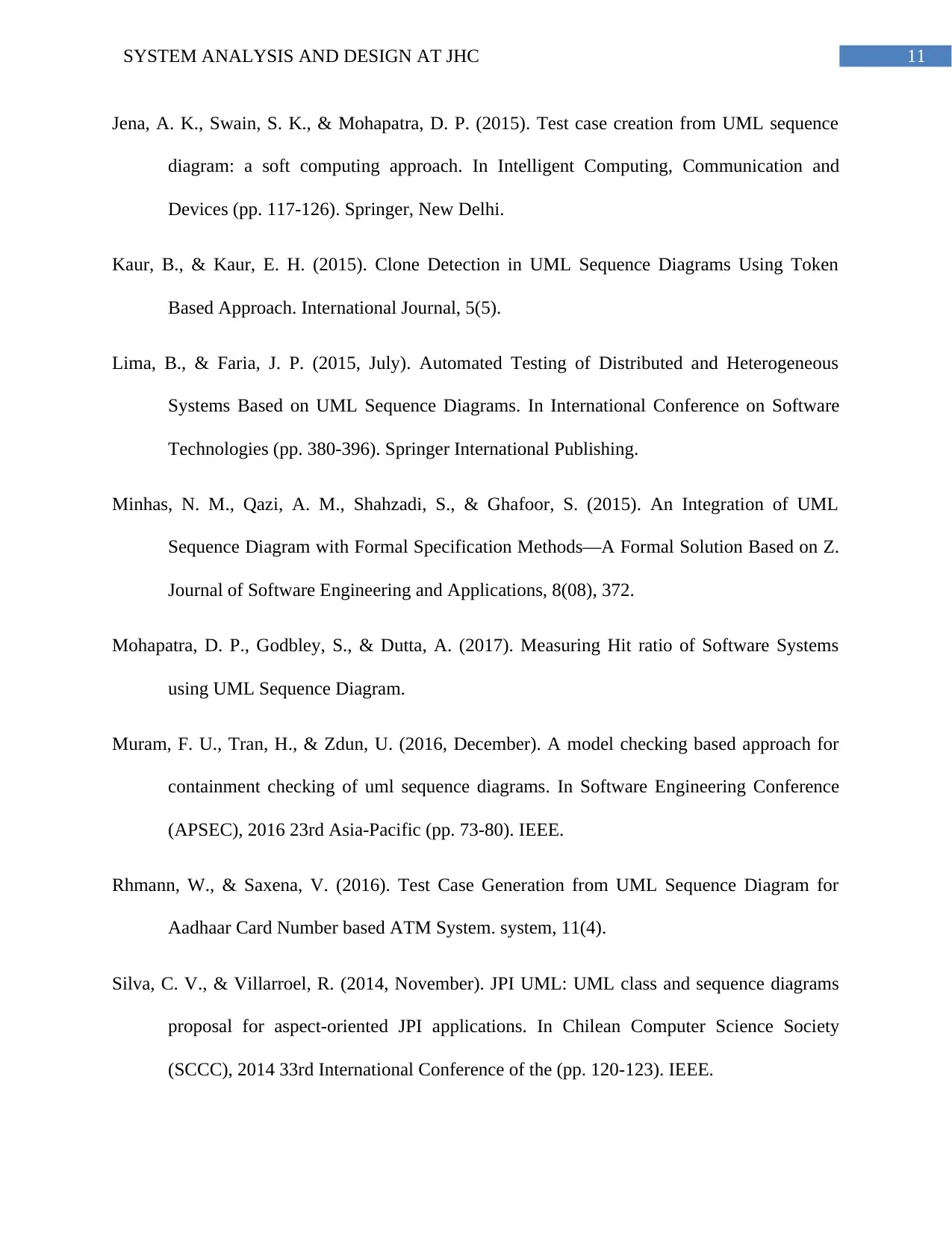
11SYSTEM ANALYSIS AND DESIGN AT JHC
Jena, A. K., Swain, S. K., & Mohapatra, D. P. (2015). Test case creation from UML sequence
diagram: a soft computing approach. In Intelligent Computing, Communication and
Devices (pp. 117-126). Springer, New Delhi.
Kaur, B., & Kaur, E. H. (2015). Clone Detection in UML Sequence Diagrams Using Token
Based Approach. International Journal, 5(5).
Lima, B., & Faria, J. P. (2015, July). Automated Testing of Distributed and Heterogeneous
Systems Based on UML Sequence Diagrams. In International Conference on Software
Technologies (pp. 380-396). Springer International Publishing.
Minhas, N. M., Qazi, A. M., Shahzadi, S., & Ghafoor, S. (2015). An Integration of UML
Sequence Diagram with Formal Specification Methods—A Formal Solution Based on Z.
Journal of Software Engineering and Applications, 8(08), 372.
Mohapatra, D. P., Godbley, S., & Dutta, A. (2017). Measuring Hit ratio of Software Systems
using UML Sequence Diagram.
Muram, F. U., Tran, H., & Zdun, U. (2016, December). A model checking based approach for
containment checking of uml sequence diagrams. In Software Engineering Conference
(APSEC), 2016 23rd Asia-Pacific (pp. 73-80). IEEE.
Rhmann, W., & Saxena, V. (2016). Test Case Generation from UML Sequence Diagram for
Aadhaar Card Number based ATM System. system, 11(4).
Silva, C. V., & Villarroel, R. (2014, November). JPI UML: UML class and sequence diagrams
proposal for aspect-oriented JPI applications. In Chilean Computer Science Society
(SCCC), 2014 33rd International Conference of the (pp. 120-123). IEEE.
Jena, A. K., Swain, S. K., & Mohapatra, D. P. (2015). Test case creation from UML sequence
diagram: a soft computing approach. In Intelligent Computing, Communication and
Devices (pp. 117-126). Springer, New Delhi.
Kaur, B., & Kaur, E. H. (2015). Clone Detection in UML Sequence Diagrams Using Token
Based Approach. International Journal, 5(5).
Lima, B., & Faria, J. P. (2015, July). Automated Testing of Distributed and Heterogeneous
Systems Based on UML Sequence Diagrams. In International Conference on Software
Technologies (pp. 380-396). Springer International Publishing.
Minhas, N. M., Qazi, A. M., Shahzadi, S., & Ghafoor, S. (2015). An Integration of UML
Sequence Diagram with Formal Specification Methods—A Formal Solution Based on Z.
Journal of Software Engineering and Applications, 8(08), 372.
Mohapatra, D. P., Godbley, S., & Dutta, A. (2017). Measuring Hit ratio of Software Systems
using UML Sequence Diagram.
Muram, F. U., Tran, H., & Zdun, U. (2016, December). A model checking based approach for
containment checking of uml sequence diagrams. In Software Engineering Conference
(APSEC), 2016 23rd Asia-Pacific (pp. 73-80). IEEE.
Rhmann, W., & Saxena, V. (2016). Test Case Generation from UML Sequence Diagram for
Aadhaar Card Number based ATM System. system, 11(4).
Silva, C. V., & Villarroel, R. (2014, November). JPI UML: UML class and sequence diagrams
proposal for aspect-oriented JPI applications. In Chilean Computer Science Society
(SCCC), 2014 33rd International Conference of the (pp. 120-123). IEEE.
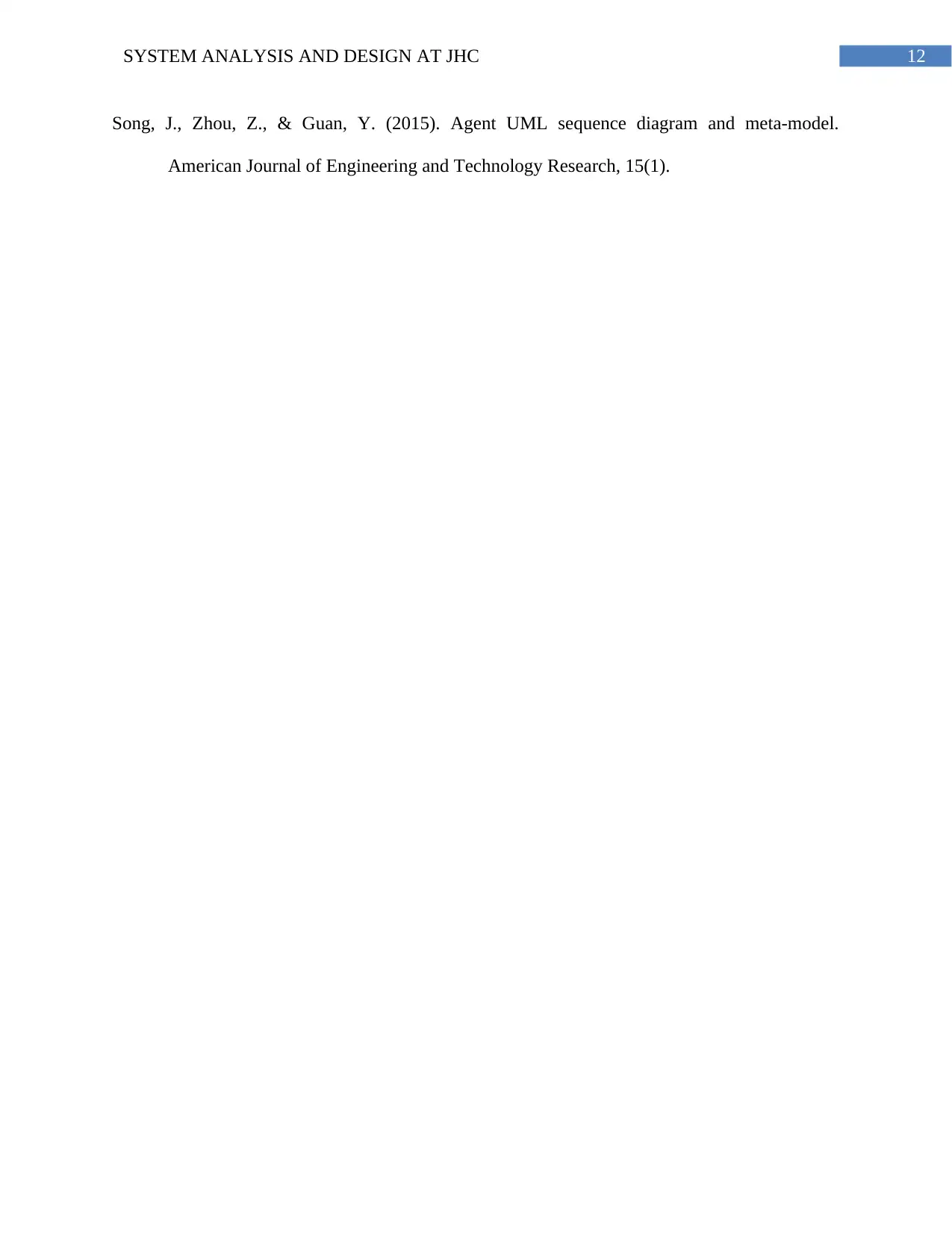
12SYSTEM ANALYSIS AND DESIGN AT JHC
Song, J., Zhou, Z., & Guan, Y. (2015). Agent UML sequence diagram and meta-model.
American Journal of Engineering and Technology Research, 15(1).
Song, J., Zhou, Z., & Guan, Y. (2015). Agent UML sequence diagram and meta-model.
American Journal of Engineering and Technology Research, 15(1).
1 out of 13
Related Documents
Your All-in-One AI-Powered Toolkit for Academic Success.
+13062052269
info@desklib.com
Available 24*7 on WhatsApp / Email
![[object Object]](/_next/static/media/star-bottom.7253800d.svg)
Unlock your academic potential
© 2024 | Zucol Services PVT LTD | All rights reserved.





